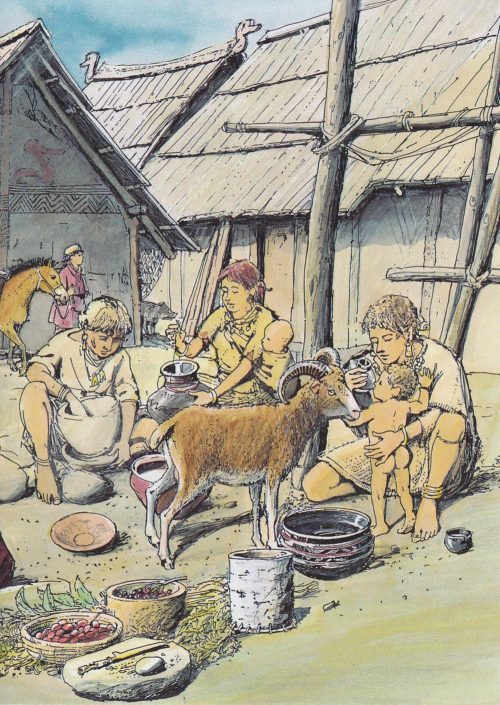These odd little pots tell a story about a revolution in human biology that occurred over 5000 years ago.
They turn out to have been milk bottles for feeding infants. That’s a reasonable inference about function from shape, but now also it’s been determined by isolating lipids still adhering to the inner surface, showing that they contained goat or cow milk. These came from cultures that had domesticated milk-giving animals, and they were using them to supplement feeding their children. Probably the adults as well, since this would have been a time when lactose tolerance was evolving.
Another effect of this change in diet: the pots were extracted from children’s graves. With new nutritional sources came exposure to new pathogens. There is evidence that these pots were heated, cooking some of the lipids into the ceramic, which makes me wonder if there wasn’t also some accidental pasteurization going on…although it’s also likely they would have just squirted fresh warm milk straight from the teat into these pots.
Counterpoint.
(No, she isn’t living on a diet of Dr Pepper, she’s just playing with an empty can under parental supervision.)





I wonder if these were serving yoghurts and not milk. As someone who developed a reaction to cows milk in my early twenties I discovered I can cope with a moderate amount of goats yoghurt, I can also cope with sheep and goats milk and a large amount of cows cheese without what some call lactose intolerance symptoms developing.
Another thing I wonder about is the pictures I’ve seen give the impression the drink is obtained from the tail!
It is entirely possible that ‘nipples’ fashioned from animal skins or organ membranes (like stomach linings or intestines that were probably already employed as sausage casings) were fastened onto the spigots of these vessels to facilitate sucking. with some appropriate twine, the large flanges on many of the vessels seem ideally suited for such attachment. Those hard spigots sure aren’t ideal for tender infant palates. People who practiced animal husbandry 5000 years ago were almost certainly adept at fashioning and curing bags to store water and other ‘beverages’ to drink from. These would be a simple extension of that technology to accommodate human and animal babies who for whatever reason could not rely on the conventional source represented by their mothers to provide them with sustenance. Milk would be much easier to warm on a fire or hearth in these ceramic vessels than in leathered bags. Also, fatty milk being like it is, such ceramic vessels seem much more easily cleaned for hygiene and indefinitely reusable compared to drinking bags.
Forgot to mention they would also serve double duty as ‘kettles’ just as they are, for cooking up broths or brewing teas or medicines stc. The legs many stand on are well suited for that purpose.
For around 9 months after I had my gallbladder removed, I was very lactose intolerant. As an infant as well.
After that, well, polished off nearly a quart last night, after bringing in a new gallon of milk and not having room for the partial.
Goat and sheep milk were milks that I could tolerate, although fattier than I prefer, I still occasionally indulge in a quart or two.
@2, my thoughts entirely on the examples with an obvious flange. Units with legs obviously using what modern camping model dutch ovens still use, to prevent scalding/burning foods by preventing the base from sitting directly on hot embers.
I am suspicious of the story as are others above. I am not sure how you would get a baby to suckle from those hard “nipples”, nor do I understand why you would want them to. The painting in the illustration is curious, that is probably a ram I think (possibly something like the old Wiltshire Horn breed), so not sure how that relates to “milk for babies”.
People die during/after childbirth
People cannot breastfeed
People have better things to do than breastfeed.
More food sources.
Wow, you seem quite an expert on infants, don’t you?
Wow, Giliell, you seem quite the expert on infants 5000 years ago. People do indeed die during childbirth and some people cannot breastfeed. In those circumstances in these kind of societies another nursing mother would take on the feeding of the baby (there were even “wet nurses” in Victorian times). People having “better things to do than breastfeed” isn’t a concept that would have been operative 5000 years ago. “More food sources” – I don’t know what this means in this context, which is about feeding infants milk from a bottle (as distinct from milk from a breast or a cup, or, later, soft food chewed by the mother before feeding to baby).
Well, apparently you are the ultimate expert who knows everything about those times 5000 years ago because you read about Victorian wet nurses. I bow to your wisdom.
She is such a beautiful child!
“People having “better things to do than breastfeed” isn’t a concept that would have been operative 5000 years ago” — I’m sorry to post just to say lolwhat, but lolwhat? Are you claiming there were no demands on Bronze Age people’s time??